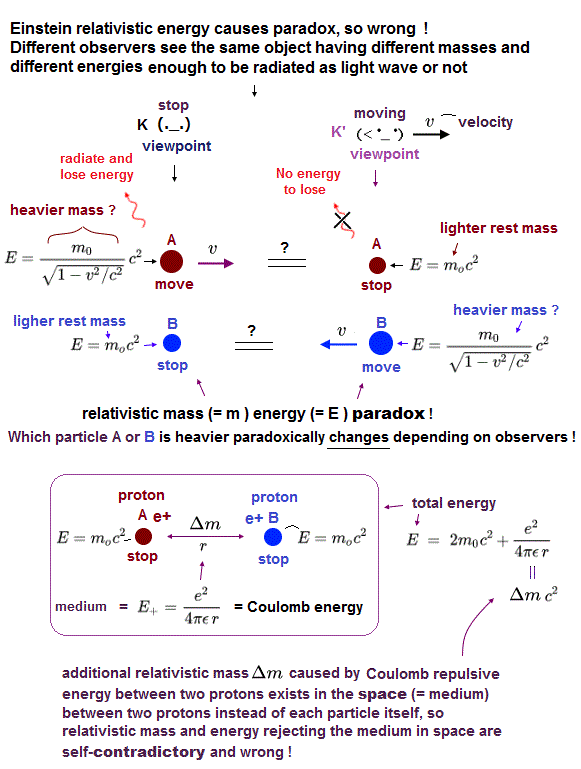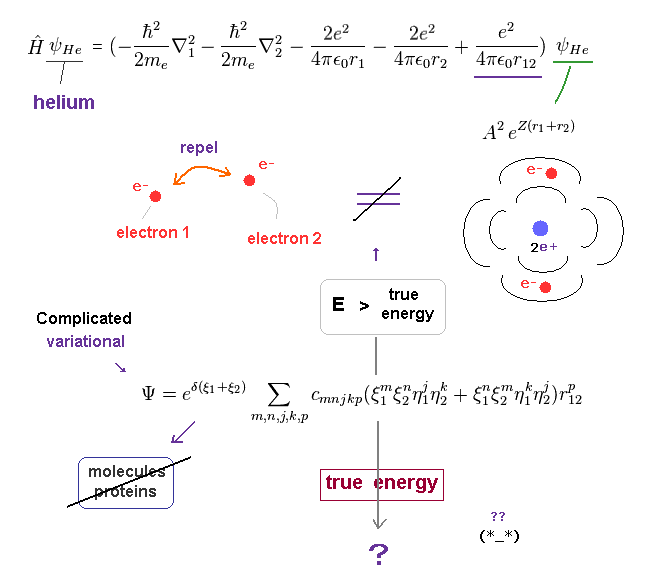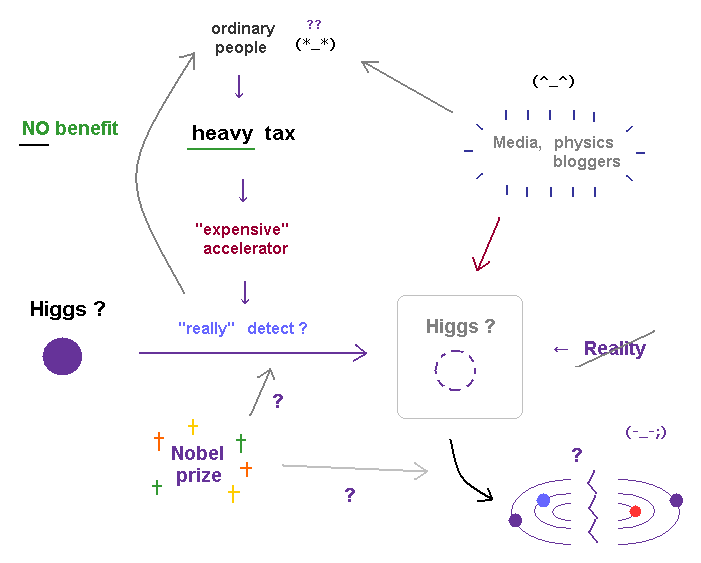
Home page
Einstein is wrong
relativistic force paradox
(Fig.1) A moving particle losing light energy to stop is paradoxically seen to gain kinetic energy by losing energy as seen by the moving K'.

In the upper Fig.1, a particle-A with the rest mass m0 is moving at a velocity v, which has relativistic energy E and heavier relativistic mass.
As seen by a stationary observer K, this moving particle-A decelerates to stop by emitting light energy (= losing kinetic energy ).
But as seen by another observer K' moving at the same speed v as the moving particle-A, the particle-A appears to stop and accelerate to the velocity v (= gain kinetic energy ? ) by paradoxically emitting (= losing ) light energy.
↑ This is clearly paradox disproving Einstein, because it is impossible for a stationary particle to increase its kinetic energy by emitting (= losing light ) energy, as seen by K'.
This relativistic (kinetic) energy or mass changed by observers is unreal, disproving Einstein relativity without absolute frame (= medium ).
The real kinetic energy (and de Broglie wave ) is caused by particles moving with respect to the medium which causes No paradox.
(Fig.2) Mass defect (= total energy decrease ) is caused by decreased potential energy in the medium around particles, disproving Einstein relativity.

The important point is that the relativistic energy or relativistic mass in nuclear binding energy has nothing to do with Einstein relativistic mass-energy which is paradoxically decreased or increased by observers' motion.
In nuclear biding energy or mass defect, the total relativistic mass is paradoxically smaller than the rest masses of particles with No kinetic energy to lose by the potential energy change ( this-1st-paragraph, this-p.1-lower~p.3 ).
↑ Einstein relativity rejecting the medium (= aether ) can never explain this nuclear binding energy (= or Coulomb energy ), because the constant rest masses of particles can never disappear (= mass defect ) to somewhere else..
This nuclear binding energy (= potential energy like Coulomb energy ) or mass defect needs the real medium where the potential (= binding ) energy ( this-1st-paragraph ) stored around the particles becomes lower due to particles binding to each other in nuclear or Coulomb force.
Mass defect in nuclear energy or forming hydrogen (= H ) atom shows the vacuum around the stationary particle already contains some real medium as potential energy (= instead of unphysical virtual particles with imaginary mass contradicting relativistic mass ).
↑ When a stationary electron and a proton (= having only rest mass energy m0c2 ) attracting each other forms a H atom, the relativistic mass-energy of the electron and proton increases due to their increased kinetic energy or velocities (from the initial zero velocity of the stationary separated electron and nucleus ) according to Virial theorem.
↑ But the total relativistic energy (= E ) or mass (= M ) of a H atom decreases (= causing mass defect of - ΔM ) due to the decreased potential energy (= -V ) despite paradoxically increasing relativistic kinetic energy or mass of the electrons and protons in the bound H atom.
This-p.4 says
"The relativistic energy of an electron in a hydrogen atom becomes smaller
than the rest mass energy"
"The behavior of an electron inside an atom, where there is potential energy,
cannot be described with the relationship of Einstein Equation"
"According to the STR (= special theory of relativity ), the electron’s mass increases when its velocity increases. However, inside the hydrogen atom, the mass of the electron decreases when the velocity of the electron increases"
The only explanation is that the relativistic mass-energy mc2 is the potential energy stored in the medium around an electron and a proton, which decreases when an electron and a proton approach each other to form a H atom by emitting light energy.
↑ If the space around electrons and protons contains nothing nor No medium (= Einstein relativity rejecting the medium ), this mass decrease in nuclear or atomic formation can Not be explained.
So the relativistic mass-energy mc2 disproves Einstein relativity denying the medium.
When two electrons at rest are made closer to each other (and these two electrons remain at rest after getting closer ), the total energy and mass increases due to higher Coulomb potential energy ( this-p.1-middle, this-middle-stored energy ). ← If the space around electrons contains No energy nor mass (= No medium ), this mass-energy increase by higher potential energy cannot be explained, which fact disproves Einstein relativity.
Actually, the relativistic mass-energy mc2 was first introduced by classical Maxwell electromagnetic theory based on the realistic mc2 or the light medium.
In fact, the relativistic energy and mass is just a copy of classical Maxwell electromagnetic theory with mc2 energy stored in the medium, which is Not Einstein's original idea ( this p.3-right-3rd-paragraph, this-p.3~ ).
So the nuclear potential energy and kinetic energy (= de Broglie wave energy ) are stored in the medium surrounding the particle, which can avoid Einstein relativistic paradoxes (= when the particle is moving with respect to the medium, which causes kinetic energy and de Broglie wave irrelevant to observers ).
A particle moving faster experiences larger resistance from the surrounding medium that is detected as a larger (illusory relativistic) mass. ← Electromagnetic force transmitted through the medium at light speed c cannot accelerate the particle faster than light, which has nothing to do with the paradoxical Einstein relativity.
(Fig.3) As the relativistic mass of a faster particle is bigger, gravity acting on the particle is bigger (= gravity = relativistic mass × gravitational acceleration g ), which paradoxically allows faster-than-light acceleration, disproving Einstein.

According to general relativistic equivalence principle, gravitational mass is equal to the inertial mass (= relativistic mass, this p.1-introduction-1st-paragraph, this-p.5-2nd-paragraph ).
↑ It means a particle accelerated by gravity increases its relativistic mass, which increases the gravitational force (= relativistic mass × gravitational acceleration g ).
So the gravitational force increasing proportional to the relativistic mass can accelerate the particle with large relativistic mass infinitely faster, even faster than light.
In Fig.3, an observer accelerating at the acceleration g sees the particle moving at almost light speed c with very larger relativistic mass (= 10000 × rest mass m0 ) and the stationary particle with rest mass m0 appearing to be accelerated in the opposite direction by fictitious gravitational force.
According to Einstein equivalence principle, this fictitious acceleration seen by the accelerating observer is equal to gravitational force.
So gravitational force is equal to the relativistic mass × gravitational acceleration g, which can accelerate even the particle with very large relativistic mass at the constant acceleration g, which eventually exceeds the light speed c, contradicting Einstein relativistic postulate of maximum light speed c.
Actually, Schwartzschild solution of black hole says the velocity of free-falling object can exceed light speed c inside event horizon of a black hole ( this-1st-paragraph ), seen by the free-falling object (= using this object's proper time, this p.7 shows free-falling object's velocity exceeds light speed, in r → 0, this p.20 ).
↑ Objects falling to the event horizon reaches the light speed c, hence, the objects falling to the inside of event horizon could be accelerated to the speed of faster-than-light, which contradicts Einstein relativity prohibiting faster than light
↑ It means escaping from black hole needs faster than light ( this-1st-paragraph, = objects falling to the inside of black hole are accelerated faster than light by black hole gravitational potential energy )
Relativistic mass is known to cause unsolvable paradoxes such as force or right-angle lever, so Einstein relativity is false.
As the result, all (unphysical) quantum field theory, QED, standard model based on contradictory virtual particles with imaginary mass (= disobeying Einstein relativistic mass-energy relation ) are useless, proved to be wrong.

Feel free to link to this site.